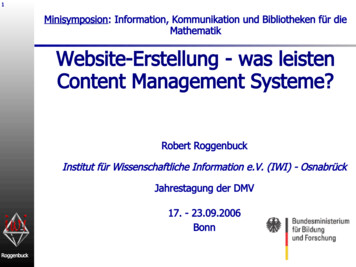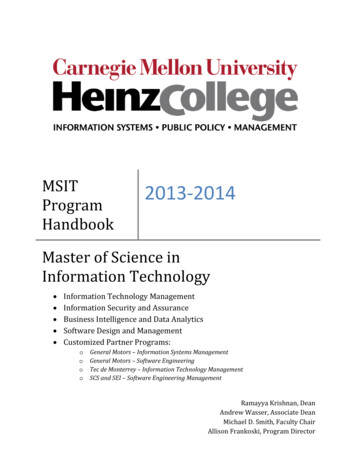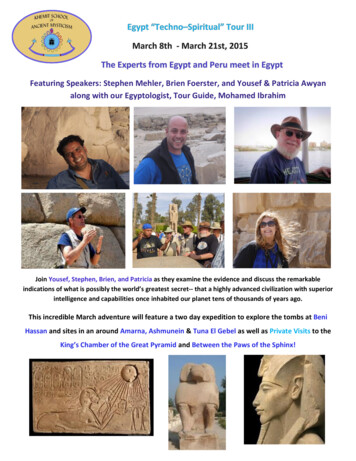
Transcription
Heinz Von Foerster,A Second Order CyberneticianStuart A. UmplebyThe George Washington UniversityWashington, DC 20052lt is a pleasure to introduce this issue of Cybernetics Forum dedicated to my triend and mentor,Heinz Von Foerster. As the following articles demonstrate, Heinz is a man who inspires not onlyadmiration and respect for his scientific contributions but also great affection. He is an outstandinghuman being as weil as a great scientist. Thearticles by Stafford Beer, Gordon Pask, HumbertoMaturana, Lars Lofgren, Edwin Schlossberg andKenneth Wilson often recount personal experienceswith Heinz. Kenneth Wilson provides a very usefuloverview of Heinz' major articles as weil as the workof visiting cyberneticians in the Biological ComputerLaboratory.I shall provide some background on how Heinzcame to the University of lllinois, a briet discussionof the effect that the Biological Computer Labaratoryhad on the students who worked there, and finallysome personal reflections on the importance ofHeinz' work for cybernetics, science, and society.The Years Before lllinoisHeinz has been a central figure in the field ofcybernetics since its beginning. During his studentdays he became involved with the Vienna Circle, agroup of philosophers that included Wittgenstein,Schlick, Menger and Carnap. From them he developed an interest in the fundamental differencebetween the world as it is and its symbolic representation in language or equati0ns. He wanted tolearn more about the observer. However, the warintervened and he spent those years in various laboratories in Germany working on plasma physics andmicrowave electronics. Luckily he survived the warunscathed in mind or body. After the war he helpedset up the first post-war radio station in Vienna andwas in charge of its science and art program until1949. ln those days of rejuvenation, he returned tothe old riddle of the nature of the observer. Withthe encouragement of the psychiatrists Victor Frank!and Otto Potzl, he published a short monograph ona quantum mechanical theory of physiologicalmemory. During a visit to the United States he metWarren McCulloch who not only had the data for histheory of memory but who also introduced him tothe campus at urbana.Through McCulloch, at conferences about Cyber·netics: Circular Causa! and Feedback Mechanisms inBiological and Social Systems sponsored by theJosiah Macy Jr. Foundation, he met the people wholaid the conceptual foundation for understanding thereally complicated systems-teleological systemsand self-organizing systems. The people attendingthese conferences included Gregory Bateson, JulianBigelow, Margaret Mead, John Von Neumann,Norbert Wiener and Ross Ashby. Heinz was so fascinated by the ideas that emerged at these meetingsthat after seven years of research at the Universityof lllinois in microwave tubes and ultra-highspeedoscillography, he went on sabbatical leave to learnmore about the neurophysiology of his enigmaticobserver. After one year under the tutelage ofWarren McCulloch at MIT and Arturo Rosenblueth inMexico 'he returned to the University of lllinois andestablished the Biological Computer Labaratory tostudy computational principles in living organisms.(1)The Biological Computer LabaratoryAlmost from the beginning it was apparent thatthe Biological Computer Labaratory (BCL) was notan ordinary university research group. One of themost amusing episodes in the history of BCL wasthe series of events that led up to Heinz's beingmentioned in the cartoon strip Pogo, a distinctionfor scientists even rarer than the Nobel Prize. (seeFigure 1) Someone at the National Institute of
A Second Order Cybernetician4 -4i::.::03 -.a0C 0;0. ' i! Cl. -4i::.::.::03 -.a0C 0a.0C 0Q.Figure 1. References to the Doomsday article in the Pogo comic strip.Health wanted a mathematical model of the population dynamics of white blood corpuscles. Heinz became interested in the dynamics of populations, boththose whose elements interact and those withelements that do not interact. He figured that dataon human population growth would be the mostcomplete set of data for a population with elementscapable of communication. The result was an articlein Science in 1960 by Heinz Von Foerster, PatriciaMora and Lawrence Amiot called "Doomsday: Friday,13 November, A.D. 2026."(2) They found that theequation which best fit the data was not an exponential but rather a hyperbolic equation. There is amajor difference. lf population is an exponentialfunction of time, population will become very !argeas time increases, but within limited time the population will remain finite. A hyperbolic function, however, has asymptotes. That is, there will be a time atwhich population will go to infinity. Applying themethod of least squares to parameterize the equation led to the date 2027, hence the title of thearticle.There followed one of the most entertaining exchanges of letters ever to appear in Science. Theidea that the human population could through communication form a coalition and engage in a gameagainst nature was a particularly troubling idea. Onedemographer called attention to the widely acceptedview that industrialization reduces rather thanincreases population. Heinz and his colleaguespointed out that if an inverse relationship betweenpopulation and technological know-how is applied tothe human population over the last couple of millennia then either Stone Age man was a technological wizard who carefully removed his technologicalachievements so as not to upset his inferior progenyor our population has dwindled from a once astronomical size to the mere three billions of today.(3)The BCL equation turned out to be considerablymore accurate than other forecasts in predictingworld population in 1970. The others were more conservative. However, 1975 data suggests that world
Cybernetics Forumpopulation has moved ahead of even the SCLequation.(4)ln addition to research the Siological ComputerLaboratory also had a significant impact on the students at the University. On even the largest collegecampuses there is usually a small group of studentswho are innovators in campus activities. They arethe students who write for the campus newspaperand Iead political or reform movements. These students usually know each other, and they often canbe found in special project courses with the moststimulating faculty members. At the University ofMichigan the Mental Health Research Institute withJames G. Miller, Anatol Rapoport, Kenneth Souldingand Richard L. Meier was a focus of innovativeactivity. Tom Hayden and Carl Oglesby were students of Kenneth Soulding. Soulding has said thatStudents for a Demooratic Society was born in hisliving room as a result of a seminar in economics.The Siological Computer Laboratory served a similarfunction at the University of lllinois. Over the yearsHeinz's students produced a Whole University Catalogue, a book on Metagames, an Ecological Sourcebook, and a large volume on the Cybernetics ofCybernetics.lt is easy to understand why there was always afeeling of excitement around SCL once one understands Heinz's views on education. Heinz notes thatmost of contemporary education is designed tomake students react to a question in exactly thesame way. Tests are given to determine how successful the system has been at making the studenta completely predictable member of society. Thehigher the score, the more predictable the student.ln other words the purpose of education is to turnnontrivial systems into trivial systems. Heinz, following Herbert Srun, defines an illegitimate question tobe one for which the answer is known. A legitimatequestion is one for which the answer is not known .Hence formal education is mostly concerned withillegitimate questions. At SCL the emphasis was onlearning to ask legitimate questions.(5)Said Heinz there are two kind s of questions.To some there are answers in lessons,But the questions that count,The ones to surmount,Are the questions that not yet are questioned.(6)To be "recruited" to SCL one only had to beattentive to the life of the campus. Secause of hishighly entertaining as weil as thought-provokingmanner of speaking, Heinz was a frequent lectureron campus. One of the first times I heard him speakwas about 1964 at the weekly luncheon series at theYMCA. ln his talk Heinz predicted that in the yearsahead people would make three discoveries. First,they would discover that the earth is finite. That is,population growth cannot continue indefinitely.Second, people would learn that power resideswhere information resides. Third, human beings5would discover that A is better off if S is better oft.Events have tended to follow these predictions. ln1968, Paul Erlich published The Population Bomb,and gradually people became more aware of rapidlyincreasing population and the impossibility of sustaining the high growth rate for very long.(7) The1970's brought greater attention to global communications-satellites, television, computer networksand also revelations about the covert activities ofthe CIA and the FSI. ln 1975 documents were madepublic which showed that during World War II theAllies were able to Iisten to the message traffic ofthe German and Japanase high commands.(8) AlanTuring was a central figure in this work. lt was noaccident that World War II was such a successfulwar for the United States. This new perspective onWorld War II helps to explain the interest of theintelligence agencies in cybernetics research. Theachievement of Heinz's third prediction-people willrealize that A is better oft when S is better off-liesin the future. While there is increasing attentionbeing paid to international development, the armsrace continues and national and ethnic rivalries persist. One hopeful sign is that a national commissionhas been set up to study the possibility of establishing a National Peace Academy. Since the U.S.now has several military academies devoted toteaching people how to win wars, it seems appropriate to have at least one academy devoted to teaching people how to resolve disputes short of war.ln about 1974, I mentioned to Heinz the three predictions he had made a decade earlier. He had forgotten about them, and he attached little significance to them. He said he had put them togethera short while before a talk because he thought theywould amuse the audience. Sut for me, those threepredictions remain an example of Heinz's depth ofinsight, broad human concern, and faith in the eventual good sense of his fellow human beings.Lest this description of the activities at SCL leavethe reader with the impression that the laboratoryled an untroubled existence, I should say a fewwords about the difficulties that Heinz faced . SCLwas a Ieader. lt was chronically ahead of its time.There was an exuberance at SCL that some interpreted as Iack of seriousness. Quite a few peoplethought that anyone with an interest in physics,li nguistics, art, music, dance, and anthropology mustbe a dilettante. And more than a few people suspected that calling attent ion to perception wassomehow subversive. Whi le the Iack of understanding was unfortunate, it did not greatly matter aslong as Heinz maintained his reputation as a successful grantsman . Sut then came the MansfieldAmendment. Most of the early work on cyberneticshad been supported by the Office of Naval Researchand the Air Force Office of Scientific Research. Sutin about 1968 the Mansfield Amendment put an endto research projects supported by the Department ofDefense which were not clearly related to a military
6mission. lt was intended that the National ScienceFoundation and other agencies would pick up thesupport of projects that had been funded by DOD.The problern of course was that these agencies didnot have people who were familiar with the work incybernetics. There followed several frustrating yearsof searching for new sources of support. MeanwhileRoss Ashby and Gotthard Gunther had retired andleft the University. Finally in 1975 Heinz retired andmoved to California. The University decided not tohire new faculty members to continue the work ofBCL. For those familiar with the laboratory, it was aheartbreaking end to a remarkable episode in thehistory of science.How to do CyberneticsBCL left behind a rich legacy. ln its day it wasone of very few educational institutions trainingpeople in cybernetics. Between 1958 and 1975 operating under 25 grants, the laboratory produced 256articles and books, 14 masters theses and 28 doctoral dissertations. The topics covered epistemology,logic, neurophysiology, theory of computation, electronic music and automated instruction. Thesematerials are available in a microfiche file compiledby Kenneth Wilson. But merely to note the range ofideas developed at BCL does not capture the feelings regarding the laboratory. Among the graduatesof BCL that I know there is a strong feeling thatthe work produced at BCL has not received theattention that it deserves. When we. go to conferences on cybernetics and systems theory, we findthat many people are still struggling with issuesthat were resolved at BCL, often quite elegantly,long ago. We believe that the field could progressmore rapidly if the work done at BCL were morewidely known. Of course other groups were alsodoing important work during this period. Great progress was being made in computer science, artificialintelligence, operations research, simulation languages, the brain sciences and other related fields.But at BCL there was more emphasis on epistemology than at most other cybernetics researchinstitutes. The different espistemology has led to asort of gap between the BCL point of view and othersystems theorists. People with a BCL backgroundexperience this gap as frustration when we try todiscuss a wide range of theoretical issues. Ourviews are often rejected for reasons which seemto us uninformed and unpersuasive. lt is apparentthat there is something rather complex going on.ln order to understand the importance of Heinz'sideas and why they have so far experienced suchlimited acclaim, it is necessary to understand howscience operates. Most scientific work follows weiltrod paths. The questions dealt with are widelyshared. The methods used are commonly practiced.A Second Order CyberneticianConsequently the results of most scientific work arereadily understood and there is widespread agree·ment about their significance within the communityconcerned.But scientific work that Ieads to the establishmentof a new area of inquiry is different in kind. Tounderstand this difference I find it useful to refer toThomas Kuhn's Iist of components of a "disciplinarymatrix." ln the epilogue to The Structure of Scientific Revolutions Kuhn identifies at least four elements of a scientific field .(9) (1) There are "symbolicE IR.generalizations" such as F ma and(2) Models and analogies include the idea that elec·tric current is similar to water flowing in a pipeand the idea that the molecules of a gas behavelike tiny elastic billiard balls in random motion.(3) "Values" could include the following propositions. Quantitive predicalions are preferable to qualitative ones. Predictions should be accurate. Theoriesshould (or need not) be socially useful. (4) "Exemp·lars" are the concrete problern solutions that students encounter from the start of their scientificeducation, whether in laboratories, on examinations,or at the ends of chapters in scientific texts.Exemplars show scientists how their job is to bedone.Work at George Washington University on a "disciplinary matrix" for the field of cybernetics has ledto two additional components. (5) "Guiding questions" state the principal concerns that motivate thedevelopment of a theory. For example, early in hiscareer Warren McCulloch asked the question, "Whatis a number that man may know it, and a man thathe may know a number?" (6) "Techniques" are themethods an author uses to persuade the reader tohis point of view. Techniques can be mathematicalor verbal. Examples are set theoretical proofs,regression analysis, computer simulation, laboratoryexperiments with animals, survey research, gedankenexperiments, and historical examples.Major changes in science seem to occur throughthe formulation of new "guiding questions" . Heinz,for instance, has been preoccupied with the natureof the observer. Progress toward the resolution ofthese questions usually takes the form of new"exemplars". The role of exemplars in the development of a scientific field is crucial. Kuhn equateshis conceptof"paradigm"withexemplars.Exemplars can be used to identify the groups withina scientific field who practice the disciplinedifferently.Those with a BCL background use differentexemplars and hence are using a different paradigm.Heinz's articles are filled with fascinating exemplars.Three of these accompany this article as illus·trations.A central concept within the field of systemsscience is the notion that a whole can be somehowgreater than the sum of its parts. (see Exemplar 1)Yet this very important idea is often not precisely
Cybernetics Forum7understood. Heinz has resolved the mystery with twosimple illustrations, one from mathematics and onefrom biology.The story of the magnetic cubes in a box demonstrates what Heinz calls "order from noise" (seeExemplar 2). I believe that it is also the most readilyunderstood Blustration of a self-organizing system.ln order for more complex systems to evolve, twothings must happen. New variety must be generated,and appropriate selection must take place. A selforganizing system is not a living system. Rather, aself-organizing system contains organisms and theirenvironments. As the system moves toward itsstable equilibrial states, it "selects" the stable relationships. The example of the magnetic cubes in aa' b' 2ab a' b'.EXEMPLAR 1On lnteractlon, the Whole and lts Parts:Communication Amongst PlanariaeA coalition is an example of the old saying that"the whole is more than the sum of its parts."Although we seem to understand very weil what thismeans, this statement has been attacked by positivists and operationalists time and again, rightly so,I think because the way it stands it clearly is nonsense. Two and two are both parts of four, but2 2 4 and not a tiny bit more or less. However,if what we want to say by this statement is properlyformulated, a most profound principle is defined. ltis the principle of superadditive compositions forelements making up a system. Let me first give aprecise formulation of this principle in ratherabstract terms, and later illustrate the application ofthis principle to pertinent concrete Situations. Whatwe really want to say is: "A measure of the sum ofthe parts is larger than the sum of the measure ofthe parts." This statement can be formulated in evenmore precise, mathematical terms. Consider F to bea measure function. lf you recall that the symbol" " stands for "left side larger than right side," theabove statement can be written in the following way:F(a b) F(a) F(b).ln order to make this highly symbolical expressionmore tangible, Iet me suggest a simple examplewhich may evoke old high school memories. Take forthe moment as an example of a measure functionthe operation "squaring;" that isF() ( )'.Squaring all F-expressions in our firstobtain:F(a b)(a b)'a' b' andF(a) a', F(b) b'.Putting the results back in the formequation, we obtain the undeniable truth box illustrates how this very general process canalso generate variety. As the separate boxes findstable relationships, they form chains. The chains ofboxes can themselves be the elements in the nextstep in the process of self-organization. ThusHeinz's example of the magnetic cubes in a boxsolves the problern of the emergence of newentities.The idea of a self-organizing system as a closedsystem (the interaction rules do not change duringthe period of observation) is one of the most important and powerful ideas in systems theory. The principle can be applied in many ways. For instance,anticipating the stable states of a system is analternative to trend extrapolation as a forecastingmethod.equation weThe margin which makes the left hand side of thisinequality larger than the right hand side is, ofcourse, the product 2ab. This provides us with animportant clue. The product 2ab is nothing eise butthe measure of the Interaction of the two parts aand b, namely the Interaction of a with b and b witha. Hence, by taking the mutual Interaction of elements in a system into consideration, the system asa whole indeed represents a more valuable entitythan the mere sum of its Independent parts. That acoalition is such a structure, where the individualelements interact for the benefit of the system as awhole, and hence for the advantage of each elementcomprising the system is, I believe, now reasonablyclear.These so called "non-linear composition rules"allow in a non-trivial way the description of systemscomposed of interacting elements. Take, for instance,a colony of about a hundred million flatworms of thegenus planaria. Each of these creatures has aboutone hundred nerve cells. Thus, all together they haveabout ten billion nerve cells. The human brain alsohas about ten billion nerve cells. Why don't thesehundred million planariae represent the intelligenceof a human brain? With this short course on superadditive composition rules, you are certainly now ina position to answer this puzzle. lt is because braincells are in a state of perpetual interaction, constantly coordinating, abstracting, and sifting pertinentInformation for the system as a whole. Poorplanariae cannot do it; add a couple of millionplanariae to our colony, and nothing changes in thestructure of this colony. They do not interact. lf theyinteract, they interact by competing for a limitedsupply of food.2abof our firstthat indeed:Heinz Von Foerster, "The Logical Structure of Environment and lts Interna! Representation," International Design Conference Aspen 1962. R.E. Eckerstrom(ed.), Zeeland, Michigan: Herman Miller, lnc. 1963.
A Second Order Cybernetician8EXEMPLAR 2MagneUe Cubes in a Box:Order From NoiseLet me briefly explain what I mean by saying thata self-organizing system feeds upon noise by usingan almost trivial, but nevertheless amusing example.Assurne I get myself a large sheet of permanentmagnetic material which is strongly magnetizedperpendicular to the surface, and I cut from thissheet a large number of little squares. These littlesquares I glue to all the surfaces of small cubesmade of light, unmagnetic material, having the samesize as my squares. Depending upon the choice ofwhich sides of the cubes have the magnetic northpole pointing to the outside (Family I), one can produce precisely ten different families of cubes.Suppose now I take a number of cubes, say, offamily I, which is characterized by all sides havingnorth poles pointing to the outside (or family I' withall south poles), put them into a large box which isalso filled with tiny glass pebbles in order to makethese cubes float under friction and start shakingthis box. Certainly, nothing very striking is going tohappen: since the cubes are all repelling each other,they will tend to distribute themselves in the available space such that none of them will come tooclose to its fellow-cube. lf, by putting the cubes intothe box, no particular ordering principle was observed, the entropy of the system will remain constant, or, at worst, increase a small amount.ln order to make this game a little more amusing,suppose now I collect a population of cubes whereonly half of the elements are again members belanging to family I (or I') while the other half are members of family II (or II') which is characterized byhaving only one side of different magnetism pointingto the outside. lf this population is put into my boxand I go on shaking, clearly, those cubes with thesingle different pole pointing to the outside willtend, with overwhelming probability, to mate withmembers of the other family, until my cubes havealmost all paired up. Since the conditional probabilities of finding a member of family II, given thelocus of a member of family I, has very mucn increased, the entropy of the system has gone down,hence we have more order after the shaking thanbefore.I grant you, that this increase in orderliness is notimpressive at all, particularly if the populationdensity is high. All right then, let's take a population made up entirely of members belonging tofamily IVB, which is characterized by oppositepolarity of the two pairs of those three sides whichjoin in two opposite corners. I put these cubes intomy box and you shake it. After some time we openthe box and, instead of seeing a heap of cubespiled up somewhere in the box, you may not believeyou eyes, but an incredibly ordered structure willemerge, which, I fancy, may pass the grade to bedisplayed in an exhibition of surrealistic art (seeFigure 2).Figure 2. An arrangement of magnetic cubesdemonstrates order form nolse.lf I would have left you ignorant with respect tomy magnetic-surface trick and you would ask me,what is it that put these cubes into this remarkable order, I would keep a straight face and wouldanswer: The shaking, of course-and some littledemons in the box.With this example, I hope, I have sufficiently illustrated the principle I called "order from noise,"because no order was fed to the system, just cheapundirected energy; however, thanks to the littledemons in the box, in the long run only those components of the noise were selected which contributedto the increase of order in the system. The occcurrence of a mutation e.g. would be a pertinentanalogy in the case of gametes being the systemsof consideration.Hence, I would name two mechanisms as important clues to the understanding of self-organizingsystems, one we may call the "order from order"principle as Sehredinger suggested, and the otherone the "order from noise" principle, both of whichrequire the cooperation of our demons who arecreated along with the elements of our system, beingmanifest in some of the intrinsic structural properties of these elements.Heinz Von Foerster, "On Self-Organizing Systemsand Their Environments," in Yovits and Cameron(eds.), Self-Organizing Systems, New York: Pergamon,1960, pp. 31-50.
Cybernetics ForumRegression fits systems just trivial.But humans are systems convivial.To say what will lastFrom times that are past,Will Iead to conclusions peripheral.9The gentleman in the bowler hat can be regardedas proof of the need for multivalued logics (see Exemplar 3). A principal concern of systems theory isthe relationship between an organism and its environment. However, it is not sufficient to speak onlyEXEMPLAR 3The Gentleman in the Bowler Hat:Autonomy, Responsibllity, Reality"The nervous system is organized (or organizes itself) so that it computes a stablereality."This postulate stipulates "autonomy," i.e., "selfregulation," for every living organism. Since thesemantic structure of nouns with prefix "self·" becomes more transparent when this prefix is replacedby the noun, "autonomy" becomes synonymous with"regulation of regulation."lt may be strange in times like these to stipulateautonomy, for autonomy implies responsibility: lf Iam the only one who decides how I act, then I amresponsible for my action. Since the rufe of the mostpopular game played today is to make someone eiseresponsible for my acts-the name of the game is"heteronomy"-my arguments make, I understand, amost unpopular claim. One way of sweeping it underthe rug is to dismiss it as just another attempt torescue "solipsism," the view that this world is onlyin my imagination and the only reality is the imagining "1." lndeed, that was precisely what I wassaying before, but I was talking only about a singleorganism. The Situation is quite different when thereare two, as I shall demonstrate with the aid of thegentleman with the bowler hat (see Figure 3). Heinsists that he is the sole reality, while everythingeise appears only in his imagination. However, hecannot deny that his imaginary universe is populatedwith apparitions that are not unlike himself. Hence,he has to concede that they themselves may insistthat they are the sole reality and everything eise isonly a concoction of their imagination. in that casetheir imaginary universe will be populated withapparitions, one of which may be he, the gentlemanwith the bowler hat.According to the Principle of Relativity whichrejects a hypothesis when it does not hold for twoinstances together, although it holds for eachinstance separately (Earthlings and Venusians maybe consistent in claiming to be in the center ofthe universe, but their claims fall to pieces if theyshould ever get together), the solipsistic claim fallsto pieces when beside me I invent another autonomous organism. However, it should be noted thatsince the Principle of Relativity is not a logicalnecessity, nor is it a proposition that can be provento be either true or false, the crucial point to berecognized here is that I am free to choose either to- - - - -· --- ------. ;G \- 1.0,.;-""" r: / f ,II'It;.:: /,0'u.:):.·J )I ·,I,---r -'L- Ji- \- ,( " /--:1·.t·'\«,/''Y"ft.1--. . C . { t.I -. I, ' ·'/I'. -r ) ,.,. ----:- ;-}/()- L 7//- ;'/' L,.II·I\ ; - /r J-VbFigure 3. The gentleman in the bowler hat. Arehis perceptions of other people fantasies orreality?adopt this principle or to reject it. lf I reject it, Iam the center of the universe, my reality are mydreams and my nightmares, my language is monologue, and my logic mono-logic. lf I adopt it, neitherme nor the other can be the center of the universe.As in the heliocentric system, there must be a thirdthat is the centrar reference. lt is the relationbetween Thou and I, and this relation is IDENTITY:Reality Community.What are the consequences of all this in ethics andaesthetics?The Ethical Imperative: Act always so as to increasethe number of choices.The A
Heinz Von Foerster, A Second Order Cybernetician Stuart A. Umpleby The George Washington University Washington, DC 20052 lt is a pleasure to introduce this issue of Cyber netics Forum dedicated to my triend and mentor, Heinz Von Foerster. As the following articles demon strate, Heinz is a man who inspires not only










